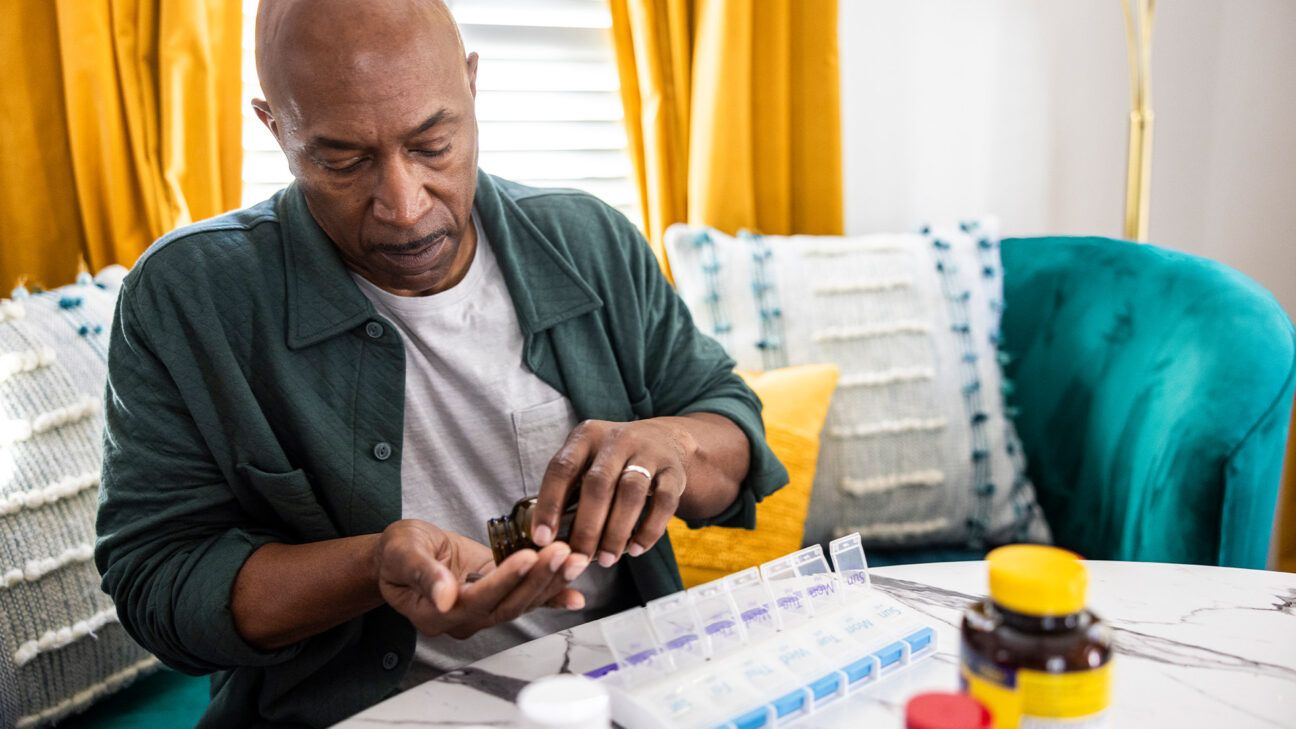How to Reduce Your Risk of Gaining Weight After Stopping Ozempic, Wegovy, or Mounjaro

- GLP-1 medications like Ozempic and Wegovy are meant for long-term use. However, some patients may stop because of side effects, cost, and accessibility.
- Research suggests regaining weight is common after cessation.
- Experts recommend staying on the medications long-term. However, they shared tips for reducing weight regain after ceasing use should a person need to stop.
GLP-1 medications like Ozempic and Mounjaro (which have been approved for treating type 2 diabetes but are sometimes used off-label for weight loss), as well as Wegovy and Zepbound (which have been approved to treat overweight and obesity), have soared in popularity due to their effectiveness as weight loss aids.
While many people find they do lose a significant amount of weight while taking these drugs, a large number of people who stop taking them discover they can quickly regain the weight they’ve lost and more — commonly referred to as Ozempic rebound.
In fact, a clinical trial published in 2022 indicated that people regained two-thirds of their body weight a year after ceasing to take 2.4 mg of semaglutide (the maximum Wegovy dose).
“Anti-obesity medications like Wegovy should not be used for short-term weight loss, but rather long-term treatment of obesity, which is a chronic disease requiring lifelong intervention,” says Dr. Katherine H. Saunders, MD, DABOM, the co-founder of Intellihealth and a physician at Weill Cornell Medicine.
However, there are a number of reasons why people may stop taking these drugs.
“Cost is a big factor,” explains Dr. Mir Ali, MD, a bariatric surgeon and medical director of MemorialCare Surgical Weight Loss Center at Orange Coast Medical Center in California. “Often, these medications, even when covered by insurance, can have significant out-of-pocket expenses. Due to their popularity, these medications can often be in short supply. Many people stop these medications when they achieve their desired goal.”
But is weight gain inevitable after you stop taking a GLP-1 drug?
Health experts say it’s complicated, and though people generally do, they can take steps to significantly reduce their risk and keep the weight off.
Why people regain weight after stopping drugs like Ozempic
Obesity is now thought of as a chronic condition, much like diabetes or hypertension.
“Therefore, it should be treated like a chronic disease, and patients need to continue the medication long-term,” Ali says.
In other words, stopping insulin might cause a spike in a patient’s A1C levels, and a person who ceases use of beta blockers for hypertension could see elevated blood pressure. It’s the same with a GLP-1.
And, like diabetes, there is no “cure” for obesity.
“These medications are treatments and not cures,” says Dr. Daniel B. Maselli, MD, ABOM, a bariatric endoscopist and obesity medicine physician at True You Weight Loss in Georgia.
As with other medications, GLP-1s like Ozempic affect a person’s biochemistry.
“These medications bind to and activate receptors in the body — GLP-1 for semaglutide,” says Maselli. “These receptors promote downstream pathways that are important for appetite regulation, insulin sensitivity, and metabolism, among other benefits, and so lead to improvements in weight and metabolic health.”
Ali adds that the stimulation slows stomach emptying, increasing the chance a patient is satiated longer (and therefore eats less).
“While these GLP-1 medications can mute those obesity-promoting pathways or heighten obesity-fighting pathways, those pathways, fundamentally, still exist,” Maselli says. “So when you remove the GLP-1 medication, that patient is set back on a course of weight increase.”
In other words, without the medication to block and promote pathways that can affect a body’s biochemistry, a person is more likely to return to consuming more calories and regaining weight.
“This is not a unique phenomenon to GLP-1 medications and is similar to what we observe with medications that treat other chronic conditions, like high blood pressure, asthma, or inflammatory bowel disease,” Maselli says.
How to reduce your risk of weight gain after stopping drugs like Ozempic
These drugs may be meant for long-term use, but as Ali pointed out, that’s not in the cards for every patient. Even though it’s not recommended, people cease taking GLP-1 drugs for a number of reasons, including the severity of side effects, medication access issues, and cost.
Yet, GLP-1 drugs aren’t a cure-all to begin with, and even clinical trials found that patients lost weight while taking these medications in conjunction with making lifestyle habit changes.
Experts shared the following tips on how to keep weight off long-term, even if you took a GLP-1 medication for a short time.
Seek support
Even if a provider doesn’t recommend going off of a medication, they can still provide support and answer questions. Use them as a sounding board.
“Everyone who has lost a significant amount of weight inevitably hits bumps in the road,” Saunders says. While Saunders feels that stopping an anti-obesity medication is a huge hurdle for a person to climb, life changes and new medications can also present challenges.
“The patients who fare best are those who reach out early to their care team for help,” Saunders says.
If possible – and you don’t have one already — add a member to your support team, like a weight-inclusive registered dietitian.
“This support system can help you navigate the mental and emotional aspects of weight fluctuations while offering health-promoting strategies that don’t rely upon a return to restrictive dieting,” says Cara Harbstreet, MS RD LD of Street Smart Nutrition.
Eat mindfully
Maselli says that no diet can perfectly mimic the biochemical effects of drugs like Ozempic and Wegovy. However, some foods can help a person feel fuller longer.
“Fiber and protein, for instance, take more time to move through the stomach and digestive tract — similar to how GLP-1 medications delay stomach emptying — and so are more filling than other types of foods,” he says.
Harbstreet agrees that foods rich in fiber and protein are beneficial. The timing of consumption also matters.
“Since protein has a similar effect for satiety, spread your protein intake throughout the day,” says Harbstreet. “In other words, avoid a pattern of small meals or lower protein foods all day before filling up on tons of protein at dinnertime.”
Harbstreet says legumes like beans offer both fiber and protein.
Whole grains and leafy green vegetables are packed with fiber. Additionally, she says that foods like avocado with healthy fats can increase and prolong full feelings.
Exercise regularly
Consistent physical activity is a hallmark recommendation for overall health and weight loss maintenance, whether a person is or isn’t on an anti-obesity medication.
“Regular exercise has a number of benefits, including increasing cardiovascular health, burning more calories, and building muscle,” says Ali. “It is important for a person to find some sort of activity that they enjoy and can do on a regular basis.”
Ali suggests doing at least 30 minutes of exercise per day, five times per week, though you may want to work up to that amount over time.
“Starting slow and building up to a regular regimen is perfectly fine,” he says.
Seek out another type of therapy
While anti-obesity medications can offer significant benefits, patients have other therapies available.
“Much like any other disease state, if one type of therapy isn’t feasible due to cost, access, tolerance, or just ineffectiveness for a specific patient, then pursuing an alternate treatment strategy is a very reasonable course of action,” says Maselli.
Maselli says these treatments may include endoscopic bariatric therapies like endoscopic sleeve gastroplasty, which can be performed as a same-day outpatient procedure and does not require long-term medication use.
Treat other underlying conditions
Maselli reminds people that obesity and overweight can put individuals at risk for more than 200 conditions, including hypertension and type 2 diabetes.
A patient on a weight loss drug like Wegovy may have one or more of them. That’s why it’s important to continue to treat these conditions after going off an anti-obesity medication.
“Left untreated, many of these conditions can reduce energy and tolerance of physical activity,” Maselli says. “It’s critical to see your physician to screen for these common conditions and treat them if found.”
Additionally, Maselli recommends asking your healthcare professional if other medications you take list weight gain as a possible side effect.
“It’s an incredibly common side effect, and many medications have a weight-neutral alternative that can be used instead,” Maselli said.
Set realistic expectations
Harbstreet says it’s important to manage expectations — you can do all of the above and still put weight back on.
“This likely isn’t what you want to hear, but the reality is that weight regain is very likely,” Harbstreet says. “Weight cycling can have a negative effect on metabolic health, as well as body image and self-esteem, so resist the urge to start another fad diet or start heavily restricting. This increases the risk of disordered eating or developing an eating disorder.”
Takeaway
Patients commonly regain weight after they stop taking GLP-1 medications, and a new, albeit small, survey indicates that patients who ceased anti-obesity medication reported consuming more calories.
GLP-1 drugs change a person’s biochemistry, making them feel fuller longer and slowing digestion. However, they do not cure obesity.
When a person stops taking the medication, its effects halt, too, and a person may return to their previous calorie consumption.
While there are steps you can take after ceasing these medications that may help reduce your risk of regaining weight, health experts say that a person’s best bet for maintaining weight loss while taking drugs like Ozempic is to take the medication long-term.
How to Reduce Your Risk of Gaining Weight After Stopping Ozempic, Wegovy, or Mounjaro Read More »







